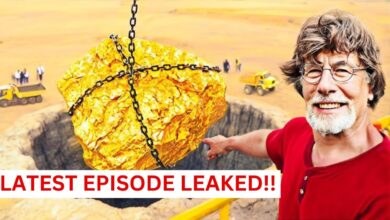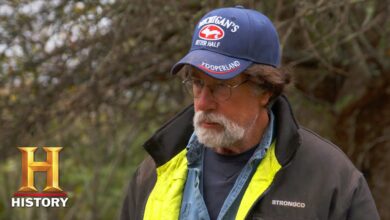The Curse of Oak Island: A Surprising Discovery at Smith’s Cove (Season 6)
The Curse of Oak Island: A Surprising Discovery at Smith's Cove (Season 6)

NA begins on Oak Island.
NARRATOR: OR: Another hy
Following an urgent phone call from an archaeologist, Rick Lagina arrives at Smith’s Cove. We, Laird and other members of the team, have just made what appears to be a surprising discovery.
RICK LAGINA: Hey, Laird.
It’s not wood.
What is it?
It’s concrete.
RICK LAGINA: What in the world is that?
(Laughing) I don’t know.
RICK LAGINA: I mean, certainly, unrecorded.
LAIRD NIVEN: Yeah.
RICK LAGINA: How deep does it go?
LAIRD NIVEN: We don’t know.
BILLY GERHARDT: It’s a bit of a surprise.
A bit?
[chuckling]
A bit?
You want– (laughing)
You want to reconfigure?
Yeah, I would say so.
NARRATOR: A concrete wall buried some feet beneath Smith’s?
I wonder if there’s a way to date concrete?
The Romans had concrete…
LAIRD NIVEN: Yeah.
RICK LAGINA: The Romans had concrete that would set underwater.
That would be incredibly old.
This could easily be…
NARRATOR: Known for such engineering feats as the Pantheon and the Colosseum, the ancient Romans were the first to develop and use poured concrete back as far as the 3rd century.
By mixing volcanic ash with other rocks and a kind of hydraulic cement, they created a unique mixture that actually hardens when exposed to seawater.
It has long been theorized that this kind of advanced engineering was required for the intricate system of booby-trapped flood tunnels on Oak Island.
There is absolutely no record of anything like this in Smith’s Cove.
So, my mind goes to, finally,
Of course, something we are absolutely certain is original.
I mean, it’d be very interesting if this goes through this structure or underneath.
Then, obviously, whoever knew about this…
If it stopped short, then this could be something entirely different from what we originally constructed.
LAIRD NIVEN: Yep.
Yeah.
Yeah.
[machinery working]
RICK LAGINA: It’s very…
In order to pour this, it is underwater.
Exactly.
That’s—
RICK LAGINA: And this is 3 feet below ground,
and then an additional 3 feet underwater.
I mean, this was not an easy build.
LAIRD NIVEN: No.
RICK LAGINA: If you were to ask me of five things we might find in Smith’s Cove, this would not be one of them.
A concrete wall wasn’t one of them.
BILLY GERHARDT: Yeah.
I said, the only thing that would have surprised me is if it was hot pink.
[laughter]
RICK LAGINA: Well, the coffin would be on top.
So there’s no wonder we didn’t see this or find it.
Sure.
Yeah.
BILLY GERHARDT: Yeah.
And there’s no mention in 1850, or 1860, or ‘66 of them using concrete.
Mm-hmm.
RICK LAGINA: We need to dig inside.
BILLY GERHARDT: Yeah.
RICK LAGINA: You know, respecting that integrity.
BILLY GERHARDT: Yeah.
RICK LAGINA: If where this is, goes that way, then when we do, we have to…
And we’ve got to call the engineer, give them the specs on what we’re doing, and get…
But I think one—
one pull through here is fine.
But any closer, it’s an all-stop situation.
Yeah.
LAIRD NIVEN: Okay.
RICK LAGINA: So, let’s just scrape this and see what happens.
NARRATOR: For Rick, Marty, and their team, the discoveries they are making suggest that the origins of Oak Island’s mystery may be much earlier and much more profound than they ever suspected.
But as they continue to dig deeper, both at the Money Pit and at Smith’s Cove, what will they uncover?
A vault filled with sacred treasure?
Ancient waterways and architecture dating back to Romans?
Or will it be evidence of something even more astounding—something so forbidden that it had to be protected by deadly traps?








